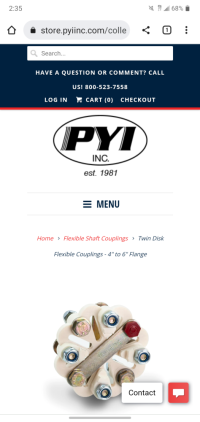Frank Langer
1984 Ericson 30+, Nanaimo, BC
Hi,
The books recommend annual engine alignment, but very few owners actually do that. I can tell when it's due by a slight increase in vibration, a little more difficulty spinning the prop by hand.
So yesterday I assembled the required tools and got to work. I almost had it, with no gap in the coupler on three sides and just a slight gap on the top fourth side, and the shaft spun quite easily. But I decided to raise the front engine mount bolt slightly to close that fourth gap, but that slight change screwed up the others so I was back to square one. I tried to reverse that last change, but it still wasn't right. I worked at it some more and got very close to good, and called it done. Today I took the boat out to check it all and sail some. It immediately became apparent that I still had more vibration than I want.
So back to the dock, tools out, and more work. I tried to be very methodical, making small incremental adjustments, both vertically and horizontally, and after an hour and a half got to no gap on three sides and a very slight two one thousands gap on the last side, with the prop shaft spinning with one finger pressure. I was pleased with that, put it all together again, and crossed it off on my To Do list.
In summary, I think engine alignment is important, though time consuming and frustrating. Sometimes it's best to know when to stop trying for perfection. If it's really not right, try again. The satisfaction of success at this nasty job is worth persevering, and then celebrating with your favourite drink.
Just my thoughts for those who haven't thought about their engine alignment.
Frank
The books recommend annual engine alignment, but very few owners actually do that. I can tell when it's due by a slight increase in vibration, a little more difficulty spinning the prop by hand.
So yesterday I assembled the required tools and got to work. I almost had it, with no gap in the coupler on three sides and just a slight gap on the top fourth side, and the shaft spun quite easily. But I decided to raise the front engine mount bolt slightly to close that fourth gap, but that slight change screwed up the others so I was back to square one. I tried to reverse that last change, but it still wasn't right. I worked at it some more and got very close to good, and called it done. Today I took the boat out to check it all and sail some. It immediately became apparent that I still had more vibration than I want.
So back to the dock, tools out, and more work. I tried to be very methodical, making small incremental adjustments, both vertically and horizontally, and after an hour and a half got to no gap on three sides and a very slight two one thousands gap on the last side, with the prop shaft spinning with one finger pressure. I was pleased with that, put it all together again, and crossed it off on my To Do list.
In summary, I think engine alignment is important, though time consuming and frustrating. Sometimes it's best to know when to stop trying for perfection. If it's really not right, try again. The satisfaction of success at this nasty job is worth persevering, and then celebrating with your favourite drink.
Just my thoughts for those who haven't thought about their engine alignment.
Frank

